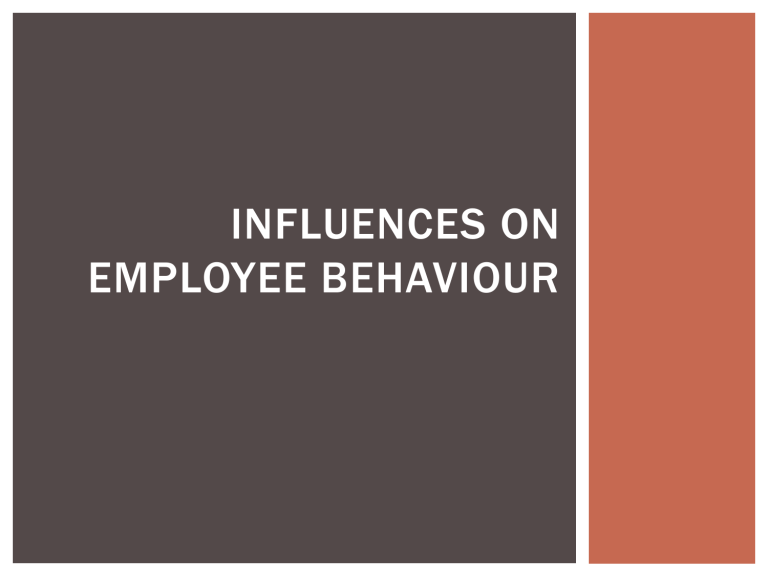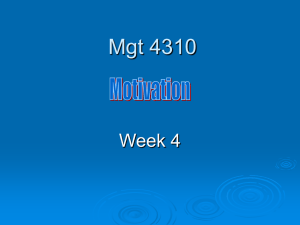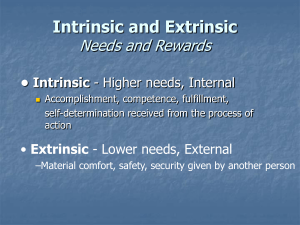
INFLUENCES ON EMPLOYEE BEHAVIOUR A MAJOR PURPOSE OF HUMAN RESOURCE DEVELOPMENT To assist employees and organizations in attaining their goals Ultimate objective is to improve organizational performance Major focus of most HRD interventions is an effort to change employee behavior MODEL OF EMPLOYEE BEHAVIOR Forces that influence behavior: External to the employee: External environment (economic conditions, laws and regulations, etc.) Work environment (supervision, organization, coworkers, outcomes of performance) Within the employee: Motivation, attitudes, knowledge/skills/abilities (KSAs) MODEL OF EMPLOYEE BEHAVIOR MAJOR CATEGORIES OF EMPLOYEE BEHAVIOR Individual performance is multidimensional Most HRD focuses on “Task Performance” Behaviors central to doing one’s job Organizational citizenship behaviors Critical to organizational effectiveness Not specific to any one task FACTORS IN THE EXTERNAL ENVIRONMENT Economic conditions Technological changes Labor market conditions Laws and regulations Labor unions S o u rc e : H e n e m a n , S c h wa b , Fo s s u m & D ye r ( 1 9 8 9 ) In spite of excellent work and production, external influences can result in down-sizing to reduce costs WORKFORCE INVESTMENT Organizations invest a lot of time and money in their workforce They must maintain their investment, even when restructuring or downsizing Re-training “survivors” to do other work rather than laying them of f Coaching and mentoring Individual development Multi-rater feedback FACTORS IN THE WORK ENVIRONMENT Outcomes Supervision and leadership Organization Coworkers INFLUENCES ON EMPLOYEE BEHAVIOR Factor Outcomes Issues Types Supervision Effect on Motivation Leadership Organization Coworkers Performance Expectations Reward Structure Organizational Culture Job Design Norms Group Dynamics Teamwork Control of Outcomes OUTCOMES CAN INFLUENCE EMPLOYEE BEHAVIOR Personal outcomes Organizational outcomes Both expectancy theory and equity theory predict that employee perceptions of the outcomes they receive (or hope to receive) influences their performance of that behavior. Expectancy Theory: Workers will perform behaviors that they perceive will bring valued outcomes Better the outcome, better the work Equity Theory Outcomes are evaluated by comparing them to the outcomes received by others SUPERVISOR CHARACTERISTICS Immediate supervisor: Delegates tasks and responsibilities Sets expectations Evaluates performance Provides feedback Rewards desirable behavior Provides discipline Leadership: Non-coercive influence to direct and coordinate the activities of a group toward accomplishing a goal Performance expectations (Pygmalion effect ): Super visor's expectations can influence workers behavior Evaluation of efforts ORGANIZATIONAL INFLUENCES Reward structure Organizational culture Job design REWARD STRUCTURE Focuses on: Types of rewards used How rewards are distributed The criteria for rewards distribution Rewards are more than money or plaques They can include recognition and acceptance THE ORGANIZATIONAL CULTURE A set of values, beliefs, norms and patterns of behavior that are shared by organization members, and that guide their behavior JOB DESIGN The development and alteration of the components of a job to improve productivity and the quality of an a employee’s life A job design can af fect behavior and attitudes Altering the job may improve performance and attitudes COWORKER INFLUENCE They control some of the outcomes and therefore some of the behavior They may of fer or withhold friendship and recognition Norms set the guidelines for behavior in the group Group dynamics influence the way an employee behaves when interacting with a group GROUP DYNAMIC CHARACTERISTICS Groupthink --concerned with unanimity rather than making good decisions Social Loafing --tendency for individuals to reduce level of ef fort as group becomes larger Teamwork: Trust Cohesiveness MOTIVATION Psychological processes that cause the arousal, direction, and persistence of voluntary actions that are goal-directed MOTIVATION CHARACTERISTICS Pertains to voluntar y behavior Focuses on processes af fecting behavior such as: Energizing—The generation or mobilization of effort Direction—Applying effort to one behavior over another Persistence—Continuing (or ceasing) to perform a behavior An individual phenomenon: Based on the individual because of unique Needs Desires Attitudes Goals NEED-BASED THEORIES Underlying needs, such as needs for survival, safety, power, etc., are what drives motivation Theories: Maslow’s hierarchy of needs theory Alderfer’s existence, relatedness, and growth (ERG) theory Herzberg’s two-factor theory NEED ACTIVATION-NEED SATISFACTION PROCESS MASLOW’S HIERARCHY OF NEEDS S e l f - Ac t ua l iz a t io n Needs Esteem Needs Belonging & Love Needs Safety Needs Survival Needs COGNITIVE THEORIES Expectancy theory Goal-setting theory Social learning theory Equity theory EXPECTANCY THEORY Motivation is viewed as a conscious choice People put their efforts into actions they can perform to achieve desired outcomes Three key elements: Expectancy – expect effort to result in success Instrumentality – performance results in reward Valence – value individual puts on outcome EXPECTANCY THEORY IN OTHER WORDS… You believe you can do it You believe your performance is linked to the results You believe that the results are worth the effort You won’t do it if you don’t believe it’s worth the effort GOAL SETTING THEORY Specific, difficult, and understood goals generally lead to higher performance Keys to success are the level of difficulty and the clearness of goals SOCIAL LEARNING THEORY Self-efficacy – judgment of what you think you can do with the skills you have Major prediction of the theory is that expectations determine: Whether a behavior will be performed How much effort will be expended How long you will perform the behavior SELF-EFFICACY AND EFFORT EQUIT Y THEORY Major assumptions: If you are treated fairly, you will keep working well If you think you are being treated unfairly, you will change your behavior in order to be treated fairly EQUIT Y THEORY A NONCOGNITIVE THEORY Reinforcement theory Based on “Law of Effect” Behavior that is followed by a pleasurable consequence will occur more frequently Process known as “reinforcement” Behavior that is followed by an adverse consequence will occur less frequently COMPLEXIT Y OF BEHAVIOR BEHAVIOR MODIFICATION Principles for controlling employee behavior: Positive reinforcement refers to increasing the frequency of a behavior by following the behavior with a pleasurable consequence Negative reinforcement increases the frequency of a behavior by removing something aversive after the behavior is performed Extinction seeks to decrease the frequency of a behavior by removing the consequence that is reinforcing it Punishment seeks to decrease the frequency of a behavior by introducing an aversive consequence immediately after the behavior A SPECIFIC EXAMPLE Sleeping in Class: 1. Warning 2. Leave class and explain to the Assistant Dean why you were asked to leave Too often – you are dropped from the class Question: Is this positive or negative reinforcement, and why? MOTIVATION AND PERFORMANCE MODEL OTHER INTERNAL FACTORS THAT INFLUENCE EMPLOYEE BEHAVIOR Motivation Attitudes Knowledge, Skills and Abilities (KSAs) ATTITUDES A person’s general feelings of favor or disfavor towards something Feelings towards a person, place, thing, event, or idea Tend to be VERY stable and hard to change Attitudes are important in training – e.g., does the trainee intend to use the training or ignore it? THE BEHAVIORAL INTENTIONS MODEL KNOWLEDGE, SKILLS AND ABILITIES (KSAS) Abilities – general capacities related to the performance of specific tasks Skills – combines abilities and capacities, generally the result of training Knowledge – understanding of the factors or principles related to a specific subject HRD programs mostly focus on changing skills and knowledge SUMMARY HRD generally seeks to change human behavior (some efforts to change attitudes) Behavior is influenced by both external and internal factors Worker motivation is the key We can work on knowledge, skills and abilities Attitudes are often where the problem lies




